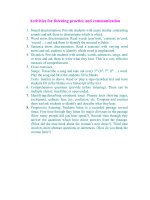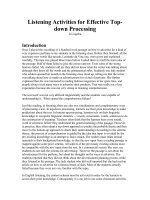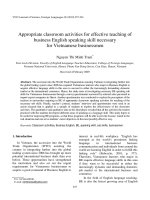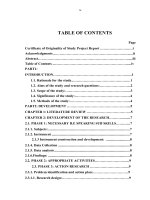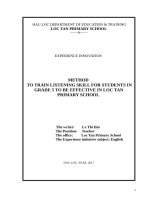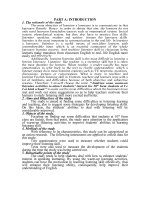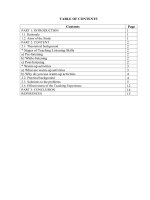Listening Activities for Effective Top
Bạn đang xem bản rút gọn của tài liệu. Xem và tải ngay bản đầy đủ của tài liệu tại đây (72.61 KB, 5 trang )
Listening Activities for Effective Top-down
Processing
Ji Lingzhu
Introduction
Once I played the recording of a hundred word passage on how to advertise for a kind of
very expensive perfume to my students in the listening class. Before they listened, all the
necessary new words like tuxedo, Leonardo da Vinci etc, were given and explained
carefully. The tape was played three times before I asked them to retell the main idea of the
passage. Half of them failed to give the correct answer. Even some of the strong learners
failed. My students told me they did not know what the writer was talking about, although
they knew all the words and the grammatical rules. Suddenly one lady student who seldom
opened her mouth in the listening class stood up, telling me that the writer was talking
about how to make an advertisement for a kind of perfume. She further explained that she
was interested in reading fashion magazines in her spare time, and people always tried
many ways to advertise their products. That was really out of my expectation because she
was not very strong in listening comprehension.
The text itself was not very difficult linguistically and the students were capable of
understanding it. What caused the comprehension failure?
Just like reading, in listening, there are also two simultaneous and complementary ways of
processing a text. In top-down processing, learners use their prior knowledge to make
predictions about the text. In bottom-up processing, learners rely on their linguistic
knowledge to recognize linguistic elements -- vowels, consonants, words, sentences to do
the construction of meaning. Teachers often think that the learners hear every sound, word
or sentences before they understand the general meaning of the passage. However, in
practice, they often adopt a top-down approach to predict the probable theme and then
move to the bottom-up approach to check their understanding.rAccording to the schema
theory, the process of comprehension is guided by the idea that input is overlaid by the pre-
existing knowledge in an attempt to find a match. The readers must relate textual materials
to their background knowledge, so that the new input from a reading passage is mapped
against some prior schema. All aspects of the previously existing schema must be
compatible with the new input from the text. In a commercial society like ours, my students
do not lack the schema for advertising. However the passage is not about the
advertisement for the perfume, but about his thoughts on the ways to advertise. The
students reported that they did not think about the advertisement planning process while
they listened to the passage. The lady student who did well reported that she had read an
article on how to advertise for a famous brand of shirt. Most of the students actually failed
because they were not very familiar with the topic.
In English listening, the content schema must be activated in order for the learners to
access their prior knowledge. Consequently it is our job to use some classroom activities to
help them. First of all, we must assess the students' level of background knowledge on a
particular topic before the students listen to the text. If the students lack specific content
schema, we should provide a remedial lesson on the topic to bring their level of content
schema up to the level where they can better comprehend the text. Or we revise the
teaching materials so that they will not be too demanding for the students. Furthermore, the
teachers can use the information gained at this time to make specific lesson plans for the
remainder of the listening lesson on that particular topic.
Activities to Activate Students' Prior Knowledge
To effectively activate the students' prior knowledge, I often use activities in my listening
class and will introduce some of them here in this article.
Word Association Tasks
This method helps to determine what prior knowledge students bring to the new topic
before they listen to the passage. They will respond to a key word or phrase such as
"Crimes are harmful to the society." They can write down as many words and phrases as
possible in five minutes' time related to this topic, or they may write freely on this topic.
While they write, they should not worry about the words and sentences they write, just pay
attention to the content. The whole process takes about ten minutes. The teacher can write
down the main ideas on the board. Then according to the information, the teacher should
adjust his/her teaching plan. The free association method of assessing background
knowledge was originally developed as part of a pre-reading plan. Later it was further
developed as a measure of prior knowledge. The learners are usually given three content
words or phrases related to a topic and asked to write anything that comes to mind when
they hear each word or phrase. We can also use the semantic webbing method. In this
approach, teachers graphically connect the various concepts and key words surrounding a
particular topic on the blackboard, helping students to see the possible relationship between
ideas discussed. Here we are not creating new knowledge, but making students aware of
the knowledge they already have by giving structure to the content information. This
process will enable them to connect what they are going to learn with what they have
already know.
This teaching process can be done as group work. Students can be divided into several
groups to discuss the topic. Usually each group will come up with different ideas. After a
few minutes, the instructor can ask the group leader to report their discussion results, and
help them to put their ideas into appropriate groups and label them properly. The students
are encouraged to refer to a dictionary as they generate their ideas.
Another Type of Pre-listening Activity Is Questioning.
Usually teachers ask students questions after they finish listening. Here my suggestion is
giving them the questions before they listen to the target text. This task more closely relates
to what happens in the real world. We most often listen to the speaker to find answers to
the questions in our minds, relating to a certain topic, or to confirm what we already
thought to be true. Pre-passage questions induce a selective attention strategy. If we use a
certain textbook, in which questions always follow a passage, we may ask the students to
read the questions first. By reading the questions, students may build up their own
expectations about the coming information, and also by trying to find answers to these
questions, their prior knowledge on the topic can be activated. They can even have a
framework of the organization of the passage to be read if the questions are arranged in a
well-arranged order.
For instance, students are expected to answer the following questions after they listen to a
passage.
• What are the benefits of the social recognition of marriage for children?
• What are the three areas the speaker will deal with in this lecture?
• What are the three possibilities for the number of mates?
• What are the possibilities for the locality of the marriage?
• What are the possibilities for the transfer of wealth?
Ask the students to read the questions carefully, they will know the main idea of the
passage is marriage customs, and the speaker will mainly talk about the benefits of social
recognition of marriage for the children, the number of mates, the locality of marriage, and
the transfer of wealth after the marriage.
We can also use the student-generated questions by giving them a topic, letting them ask
questions about what kind of information they would like to know, and then asking their
classmates to give answers to the questions. Before they listen to a dialogue between a
policeman and a thief, tell them who the two speakers are, then ask what they may talk
about. You may also ask the learners to role play the dialogue.
However, this method may not be very appropriate for opinion-giving text or fiction. It is
best used for passages that provide factual information. If the passage is too long, one
possible solution for the teacher is divide the text into sections and implement the approach
section by section.
Making List of Possibilities / Ideas / Suggestions
When the text contains lists, even short lists of possibilities /ideas /suggestions or whatever,
it is often a good idea to use list making as the pre-listening activity. This way the students
can use their lists during the listening stage. While the students make the list, they can use
the words and phrases they have already known, or they can ask their partners to help. Any
checking type activity carried out while listening can then be limited to matching with
known language. This can increase the likelihood of students succeeding with the task. So
it is a very motivating activity, especially for the lower level students.
The list making activity is very good for pair or group work. Students can work it in a
relaxed atmosphere because there is no right answer as to what should be on the list. In the
beginning of the course, when the students are not very familiar with the activity, we may
use list-making for the subjects about which people are very familiar since they are likely
to have a lot of ideas. For instance, "the food people like to eat", "things children are afraid
of", etc.
Looking at Pictures Before Listening
I have used this many times with younger learners because they are good at reading
pictures. If you want to check whether the students can name some of the items in the
listening text, pre-listening "looking and talking about" is an effective way of reminding
the students of lexis which they may have forgotten or never known. It will also help them
to focus their attention on the coming topic. This is very good for narrative or descriptive
passages.
Why Are These Activities Important?
Listeners do make use of background knowledge for comprehension. Therefore it seems
logical to teach background knowledge in the second language program. In China, the
textbooks for listening are chosen by the department leaders and teachers are required to
follow the book closely. The texts are taken from various resources from English speaking
countries, which put emphasis on authenticity. These materials cover a wide range of fields
in the target language culture. However, our students are not culturally ready for these kind
of materials. They are forced to listen to the unknown, the remote and the bizarre, so that
they cannot use the top-down processing strategies very effectively.Therefore they are
forced to listen word by word or even sound by sound. Several scholars recommended the
use of narrowed materials, possibly with the local materials, such as school newspapers,
local novels etc (Carrell& Eisterhold, 1983). They are right to a certain extent. However as
foreign language learners, they cannot always stick to narrow materials, we may start from
narrow materials and gradually move to authentic materials. So at the beginning of the
course, students should be given a pre-test on their background knowledge. Then we may
present listening passages in a graded order to ensure that for every topic the students have
some prior knowledge. The passages that are learned first would provide background for
later passages.
Pre-listening activities usually have two primary goals: a. to bring to consciousness the
tools and strategies that good listeners use when listening, and b. to provide the necessary
context for that specific listening task. Studies show that learners comprehend more of a
text if they are familiar with the text from experience or they have known something about
the topic before or they know in advance what the listening passage concerns. The four
kinds of pre-listening activities help to activate students' prior knowledge, build up their
expectations for the coming information and sometimes even give them a framework of the
coming passage. In this way we can help our students to comprehend better.
What Influences Our Choice of Top-down Activities?
The choice of the activities will depend on a number of factors, such as:
• the time available;
• the material available;
• the ability of the class;
• the nature and content of the listening text itself.
The last item on the list " the nature of the listening text itself" is very important when
choosing activities. Some kind of activities are simply not appropriate to some types of
text, and in other instances, the text itself very naturally makes one type of activity
especially appropriate.
Listening texts which naturally rise to certain kind of top-down activities are particularly
useful and generally quite motivating for the students.
When the instructor designs these kind of activities, they should also take the time element
into consideration. You cannot have a fifteen- minute activity for a passage which will last
only three minutes. Remember the pre-listening process should not last longer than the
actual listening activity. The learners' proficiency is also a factor to consider. The activities
should not be too demanding, otherwise the students will lose their interests.
Conclusion
Top-down processing is very important in listening comprehension. In our native language,
we do not listen to the speaker word by word, and we are sometimes one step ahead of the
speaker. Our students' cognitive level is quite high, and they are quite strong in
comprehension. The only problem is that their English is not very good. Using top-down
activities can quickly help them to transfer their mother tongue listening strategies into
English listening. Activating prior knowledge is crucial in top-down processing.
